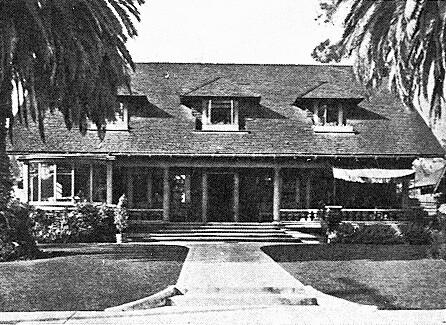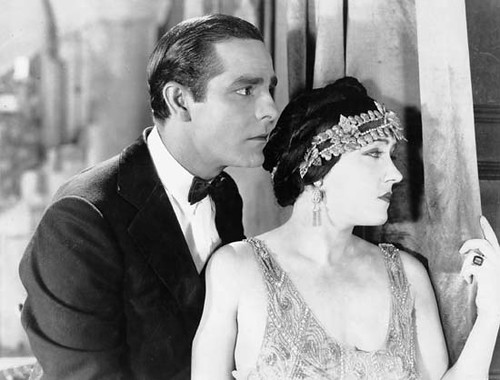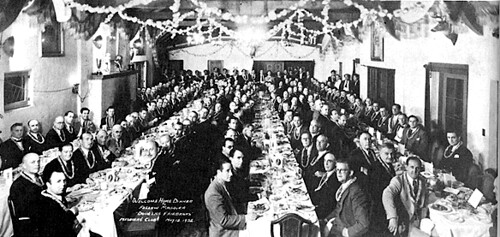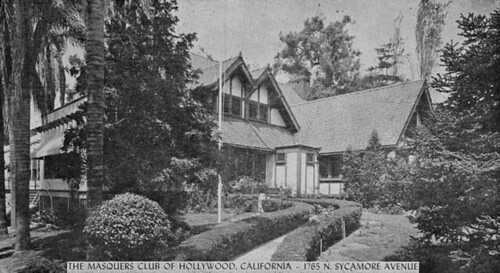(Site of) Masquers Club Building
c. 1918
1765 North Sycamore Avenue – map
Declared: 8/29/79
I’ll admit I never heard of the Masquers Club until this landmark popped up on the list. However, I sure recognize many of its former members, including just about every name actor of the 1930s and 40s I can think of. And the genesis of the old clubhouse itself – gone for nearly twenty-four years now – lies with another actor, one I thought I didn’t know but I guess I really did.
Eight men in May 1925 got together to form Hollywood’s first actors club, one, like the Lambs in New York, which would be a “social sanctuary for actors and the theatrically inclined.” For a fleeting moment the men were calling themselves the Jesters, but when they found out the Shriners laid claim to that name, it was Earle Foxe who came up with the name Masquers (you may remember Foxe from such films as The Cub Reporter’s Temptation, Ladies Must Dress, and Rah! Rah! Heidelberg!). And it was the club’s first president, Robert Edeson (A Man’s Prerogative, The Colonel’s Peril, and Has the World Gone Mad!), who coined its motto, “We laugh to win.”
The club set up headquarters in the home below at 6735 Yucca Street (it, too, is gone). The Masquers remained here until the end of April 1928 when they relocated a couple of blocks west to North Sycamore (6735 later served as club for the Shriners).
The Masquers’ first home, on Yucca.
Now we leave that narrative thread to pick up this one: Antonio Moreno, born Antonio Garride Monteagudo in Madrid in 1887, was a popular Latin lover-type in silent films, appearing with Gloria Swanson, Pola Negri, Dorothy Gish, Greta Garbo, and Clara Bow. His career lasted until 1959, a few years after he acted in The Creature from the Black Lagoon and John Ford’s The Searchers. Sometime in the mid-teens, Moreno built himself a two-story Tudor home with fifteen rooms just above Hollywood Boulevard. In 1928, he sold his home to the Masquers whose alterations to the building were to accommodate an English tavern, theater, stage, dining area, kitchen, switchboard, reception office, and entrance lobby. Moreno was a Masquer himself, and was one of the club’s few life-members. (Antonio gets the nod for having lived in two Historic-Cultural Monuments, building with his wife, Daisy Canfield, Silverlake’s Canfield-Moreno Residence, HCM No. 391.)
Moreno and Gloria Swanson in My American Wife
In 1930, when club membership was limited to 700 men, the Los Angeles Times called the Masquers Club Building “one of the most charming, old-fashioned, two-story houses on Sycamore street. It is surrounded by spacious ground filled with trees and shrubs and a large parking space for cars as naturally everybody owns a car. On the first floor is a large dining-room with a small stage at one end on which the club revels are presented every six weeks.” I can’t figure if the “naturally everybody owns a car” line is sardonic or not.
The Masquers club was the type of fraternal organization you’d expect it to be, I guess. Charitable functions, all-male public performances which the club called “revels” (the first being held in downtown’s Philharmonic Auditorium), the annual picnic, or “mess”, often held at John Ford’s Encino ranch, and lots of dinners and tributes and such (the picture below is of a 1932 wing-ding honoring Doug Fairbanks). Oh, and the partying, too. A police raid in April 1930 netted a case each of gin and whiskey when a copper pressed a button under the café’s manager’s desk revealing a secret compartment behind a wall (“I’m shocked. Shocked!”). Go figure – booze on the premises, what with members at one time or another John Barrymore, Errol Flynn, John Gilbert, Buster Keaton, Frank Sinatra, Stan Laurel, Humphrey Bogart, Joe E. Brown, and W.C. Fields.
Honoring Douglas Fairbanks
The Masquers Club was also in the movie business, co-producing as an entity a series of two-reelers for RKO from 1931 to 1933. And it members, along with those of the Dominos (a Masquers Club for dames) and the Hollywood Cricket Club, were instrumental in the 1933 founding of the Screen Actors Guild. Plus, the clubhouse served as a military canteen and entertainment center during WWII.
In late 1965, the Masquers began to admit skirts into the mix but as “auxiliary members”. Some Masquerettes whose names I recognize: Maureen O’Hara, Mia Farrow, Jane Wyman, Gena Rowlands, Jane Wyman, Edith Head, and Lee Meriwether.
Masquers presidents – called “harlequins” – included Joe E. Brown, Frank Morgan, Pat O’Brien, Charlie Chase, Lou Costello, and Gene Autry. Producer Joe Pasternak was a harlequin from 1970-1978, and the club’s last harlequin on North Sycamore was actor Tony Caruso.
By 1985, the Masquers Club was in big trouble. The organization was struggling with a mortgage of $2,200 on top of being in debt to the tune of about $335,000 (I can’t answer why, after nearly sixty years, the Masquers didn’t own their clubhouse). Membership was low, and with dues at $10 per month, the club would’ve needed a whole hell of a lot of Masquers to make even a dent toward recovery.
In stepped Century City’s Urban Pacific Development Corp, buying the city landmark for $475,000. The good news was the money allowed the club to continue, the bad news its clubhouse would be razed to make way for a fifty-unit apartment building. The Cultural Heritage Board didn’t raise a fuss since the Masquers were leaving and the building had been so altered since Moreno built it seventy years earlier. Last minute attempts at preserving – and maybe even moving – the building failed. Members held a final wake for the clubhouse on Saturday night, April 28, very, very close to the 57th anniversary of their moving in.
Here’s the site of the Masquers Club landmark today, home of Westbury Apartments:
The Masquers moved downtown to the Variety Arts Center on Figueroa where owner Milt Larsen donated that landmark’s third floor to the club for use as its new headquarters. Although some of it disappeared in the club’s final days on Sycamore, the Masquers’ extensive memorabilia collection went with them. I have no idea where all that stuff, including the club’s famous nude murals by Henry Clive, eventually wound up.
Although it has no clubhouse, the Masquers Club still exists today with William Malin as its current harlequin. Membership is by invite only, although at $55 a year (cheap!) it’s less expensive today than it was twenty-five years ago.
Sources:
“Button Pressing Reveals Liquor” The Los Angeles Times; Apr 13, 1930, p. A5
Thompson, Paul “Show Without Women Will be Given” The Los Angeles Times; May 4, 1930, p. B11
Dean, Paul “Unmasking Masquers: End of a Landmark?” The Los Angeles Times; Apr 25, 1985, p. H1
Up next: Janes House







7 comments:
What frightens me most is that even after receiving landmark status a structure doesn't seem to be safe from the wrecking ball. I thought that sealed the deal but not in the case of this building and the pallet tower.
That banquet photo is a hoot
Silent film comedian Raymond Griffith died at the Masquers' Club in 1957. He choked on a piece of food he was eating, and the Heimlich Maneuver had not been invented yet.
Thanks, silentfilm. I had no idea who he was, but turns out Lew Ayres killed Griffith in All Quiet on the Western Front, not by choking, though.
My biography of silent film comedian Raymond Griffith appeared in the magazine Classic Images, and can be found at http://www.silentfilmstillarchive.com/raymond.htm .
Ya did it again FB. Im reading through the text for this HCL and click on the link to the Hollywood Cricket Club to find one of my favorite actors was its founder. C.Aubery Smith. Smith played Gen.Burroughs in the 1939 film The Four Feathers,one of my favorite films. I had to laugh. I also am a fan of Henry Clives work and would also love to know what happened to the paintings at the Masquers Club only six of Clives original works are known to exist.
I didn't know Milt Larsen owned the Variety but it makes sense since he owned the Magic Castle with his brother,Bill. Bill and Irene Larsen were my neighbors on Longwood Ave. and they had a marvelous theater in the backyard,across the stream that ran behind our houses.
Worked at this building in early 1980's. Went to find the building on recent trip to Hollywood. So sad. met Gene Autry here as they had roast for old stars. ;(
Post a Comment